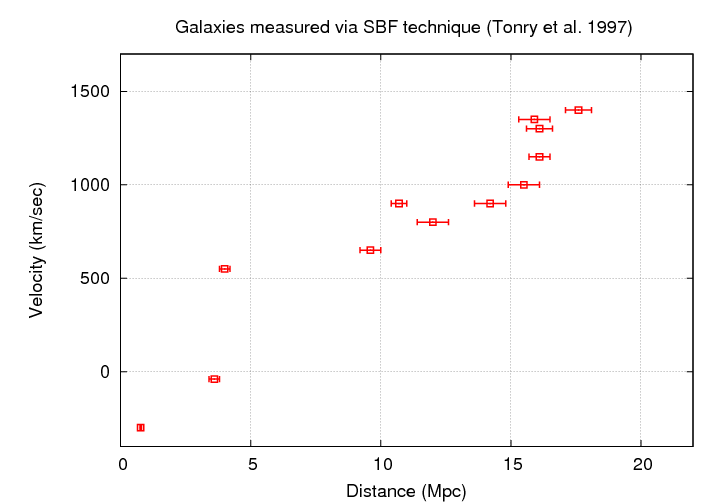 Copyright © Michael Richmond.
This work is licensed under a Creative Commons License.
Copyright © Michael Richmond.
This work is licensed under a Creative Commons License.
Why are there two "families" of H0?
One of the cosmological parameters which drives
a great deal of astronomical research is
H0, also known as Hubble's constant.
It is simply (hah!)
a local measure of the rate at which the universe
is expanding.

Data taken from
Tonry et al., ApJ 475, 399 (1997)
Q: Using the data above, what is the local value of H0?
For the real meat of today's menu,
please visit one of the lectures in another
class of mine, one concerned with
the Cosmological Distance Ladder
.
Some important concepts from this class
What might appear on a test question?
Well, any of the following are fair game --
but this is not an exhaustive list.
- extinction by the Earth's atmosphere
- extinction and reddening in the ISM
- cross-sections and event rates for particle detectors
(e.g. neutrinos, gamma rays)
- the blackbody spectrum, peak wavelength at a given temperature
- brehmsstrahlung radiation
- the virial theorem
- diffraction and its effect on angular resolution
- line emission from atoms (especially hydrogen)
- optical depth and mean free path of photons
- typical properties of CCDs and CMOS detectors
- spectral resolving power R
- basic optical properties of a generic telescope
- basic optical properties of a diffraction grating
- radio regime: spectral index
- radio regime: brightness temperature
- signal and noise for a Poisson-like source
- physics: gravity, Kepler's Laws
- physics: non-relativistic Doppler shift, relativistic Doppler shift and redshift
- astronomy: Hubble's Law
- conversions: degrees to radians, square degrees to steradians
- conversions: meters, AU, parsec
- conversions: energy, wavelength, frequency
- conversions: intensity and magnitude, distance modulus and distance
- conversions: magnitude to flux
 Copyright © Michael Richmond.
This work is licensed under a Creative Commons License.
Copyright © Michael Richmond.
This work is licensed under a Creative Commons License.

 Copyright © Michael Richmond.
This work is licensed under a Creative Commons License.
Copyright © Michael Richmond.
This work is licensed under a Creative Commons License.

 Copyright © Michael Richmond.
This work is licensed under a Creative Commons License.
Copyright © Michael Richmond.
This work is licensed under a Creative Commons License.